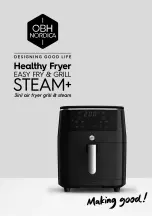
12
30A215-Mar2008
13
30A215-Mar2008
A. GENERAL: Safe and satisfactory operation of a gas fryer depends on its proper installation. Installation must conform to local codes
or, in the absence of local codes, with the current National Fuel Gas Code ANSI Z223.1 (latest edition). In Canada, gas installa-
tion shall be in accordance with the current CAN/CGA B 149.1 and .2 installation codes and/or local codes.
Each gas fryer should be installed as follows:
1. Placed beneath a properly designed exhaust hood
2. Installed by a licensed plumber.
3. Connected to the type of gas for which the unit was fabricated as shown on the rating plate.
4. Connected to the proper size pressure regulator installed in the gas supply line and adjusted to the proper manifold pressure.
5. Connected to the main gas supply line with the proper size supply line.
6. Restrained by use of a restraining device to avoid splashing of hot liquid and to assure tension cannot be placed on the gas or
electrical connections. CLEARANCES: The appliance must be kept free and clear of all combustibles. The minimum clearance
from combustible and non-combustible construction is 6" (152 mm) from the sides, and 6" (152 mm) from rear. The fryer may
be installed on combustible floors.
NOTE: Adequate clearances must be provided for servicing and proper operation.
B. STANDARDS: Installation must be planned in accordance with all applicable state and local codes, taking into account the following
standards:
1. The fryer and its individual shut-off valve must be disconnected from the gas supply piping system during any pressure testing of
that system at pressures in excess of 1⁄2 psig (3.45kPa). In Canada, gas installation shall be in accordance with the current CAN/
CGA B 149.1 and .2 installation codes and/or local codes.
2. The fryer must be isolated from the gas supply piping system by closing its individual manual shut-off valve during any pressure
testing of the gas supply piping system at pressures equal to or less than 1⁄2 psig (3.45kPA).
3. When installed the fryer must be electrically grounded in accordance with local codes, or in the absence of local codes, in
accordance with the current National Electrical code ANSI/NFPA 70 (latest edition). In Canada electrical installation must be in
accordance with the current Canadian Electrical Code CSA C22.1 and CSA C22.2 as applicable.
4. Other applicable nationally recognized installation standards such as:
a. National Fuel Gas Code ANSI Z223.1 (latest edition)
American Gas Association
1515 Wilson Blvd.
Arlington, VA22209
b. NFPA Standards #54, #94 and #221 (latest edition)
National Fire Protection Association
470 Atlantic Avenue
Boston, MA 02110
c. ANSI Z21.69/CAN/CGA-6.16 AND Z21.41/CAN1 6.9
5. Exhaust hood, when installed must conform to the current NFPA 54-1 and Canadian CAN/CGA-1.11 (latest edition)
NOTE: Local building codes will usually not permit a fryer with its open tank of hot oil to be installed immediately next to an
open flame of any type, whether a broiler or an open burner or range. Check local codes before beginning installation.
C. AIR SUPPLY AND VENTILATION: The area around the appliance must be kept clear of any combustible or flammable products and
avoid any obstruction to the flow of ventilation air as well as for ease of maintenance and service. NOTHING is to be stored in
the interior of the fryer’s cabinet except the filter tub assembly.
1. A means must be provided for any commercial, heavy duty-cooking appliance to exhaust combustion wastes outside of the
building. It is essential that a fryer be set under a powered exhaust hood or that an exhaust fan be provided in the wall above the
unit, as exhaust temperatures are in the vicinity of 400˚F (204˚C).
WARNING
Strong exhaust fans in a hood or in the overall air conditioning system can produce slight air drafts in the room, which
can interfere with burner performance and be hard to diagnose. Air movement should be checked during installation
and if burner problems persist, make-up air openings or baffles may have to be provided in the room.
2. Exhaust temperature, in addition to the open tank of hot oil, make the storage of anything on shelving over or behind the fryer
unsafe.
3. Filters and drip troughs should be part of any industrial hood, but consult local codes before constructing and installing any
hood.
4. Provisions must be made for an adequate supply of fresh air and adequate clearance must be maintained for air openings into the
combustion chamber.
PDF compression, OCR, web optimization using a watermarked evaluation copy of CVISION PDFCompressor














































